Dell XPS 13 (Q1 2013) Ultrabook Review: What a Difference 1080p Makes
by Dustin Sklavos on March 21, 2013 5:00 AM ESTDisplay Quality
Where the current generation XPS 13 makes a clean break with its predecessor is the stunning 1080p display. The Dell XPS 12 also features a 1080p IPS display, but due to the 12.5" panel (as opposed to the 13.3" in the XPS 13), pixel density is increased. The XPS 12 Duo does make an interesting counterpoint to the XPS 13 due to its inclusion of a convertible touchscreen display.
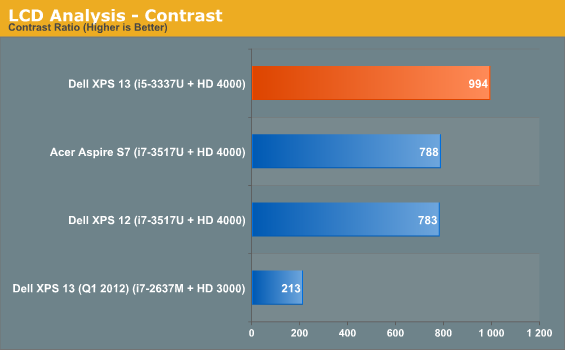

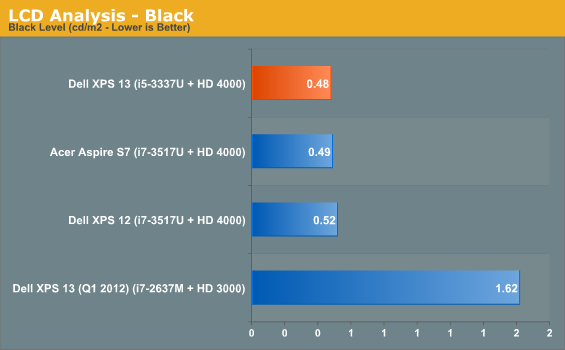
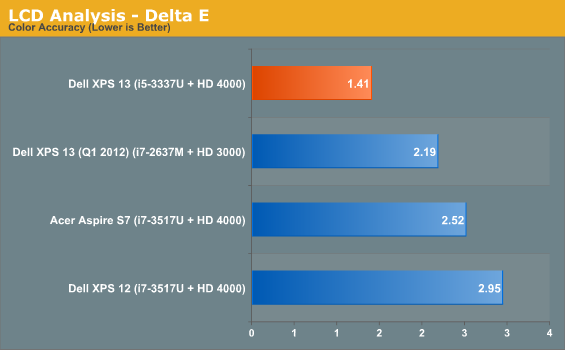
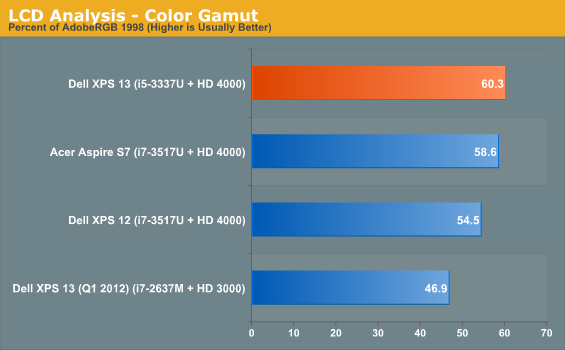

Despite the greater pixel density, though, the XPS 13's display blows away the XPS 12's in every metric, to say nothing of the way it levels the 2012 XPS 13's panel. Dell advertises the panel's brightness as being 350 nits, but we measured an almost searingly bright 477 nits.
Where the XPS 13 can become frustrating, though, is its use of adaptive brightness. The display is often much dimmer than ideal, and while adaptive brightness can be useful on a smartphone, on a notebook that feature's value is much more questionable. The XPS 13's brightness can shift semi-frequently, and I never found it to be where I actually wanted it. Thankfully, it can be disabled in the Display settings under the Windows Power Manager.
Noise and Heat
Thermally, the newer XPS 13 peaks at essentially the same temperatures as the last generation model. You can see that below in the HWMonitor results, but that doesn't really tell the whole story.

These thermals are pretty much par for the course for an ultrabook, but the difference lies in the way the XPS 13 actually handles the heat. Peak load noise is far lower than the first generation and nowhere near as high pitched; in fact, this is actually one of the quietest ultrabooks I've tested, and it has to be pushed pretty hard just to get the fan noise really going. I still take issue with the ventilation being on the bottom (as all it really takes is a comforter to clog up the vent and suffocate the system), though.
I suspect Dell has tuned the fan's behavior somewhat with the new XPS 13, but I suspect there's a combination of factors that lead to this model being much less obnoxious. Ivy Bridge is better suited to ultrabooks than Sandy Bridge ever was, Dell switched from DDR3 to DDR3L (which can easily shave a couple of degrees off the internal temperatures), and we're on QS77 instead of QS67 which means there's no external USB 3.0 chip. Little things can add up over time, and we're left with a frostier, quieter notebook than we had before.
Battery Life
Our 2013 battery tests are more punishing on the system, and results wind up being lower than they used to be. We no longer measure how long a system can idle, and brightness is up to 200 nits from 100 during testing, which can and will have a huge impact on battery life.
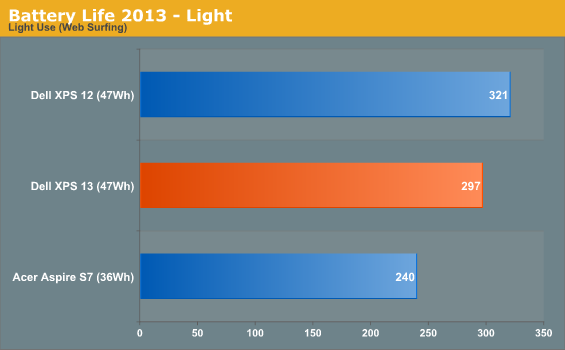

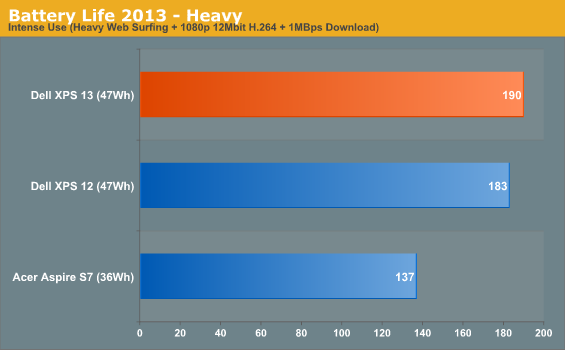
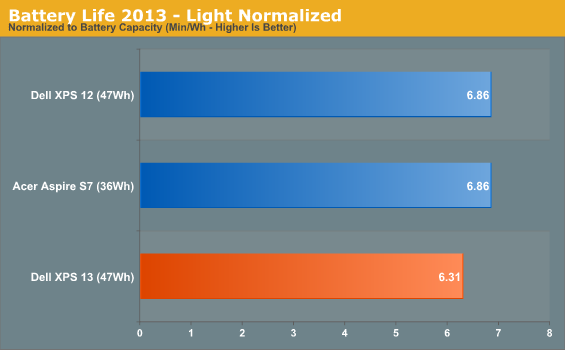


Running time under light usage for the new XPS 13 is solid if not exceptional, but when the notebook is pushed, it starts to show a more efficient performance than the others. The XPS 12 and XPS 13 are using the same battery, but the 12 has a slightly faster processor and smaller display, accounting for at least some of the difference.










53 Comments
View All Comments
DanNeely - Thursday, March 21, 2013 - link
"t should surprise no one that the RAM is soldered to the board; there's also a black sticker layer that sits between the mSATA SSD and the inside of the bottom panel. It's good to know that you can replace the mSATA drive and wireless card, though, should you need to/desire to."Is there anyone who's more interested in swapping the wifi card than they would have been in upgrading the ram in a few years? The former's something that IMO should have been at the top of the list when looking for ways to shave a few cubic mm.
moep - Thursday, March 21, 2013 - link
Dell is more interested in selling you a new laptop than letting you swap the RAM, so that’s that.baldun - Thursday, March 21, 2013 - link
The problem is not integrating the WiFi card to the motherboard. The problem is with regulatory for each country. If the WiFi card is with antenna connectors, then the regulatory certification is handled by the card vendor, in this case Intel, paying millions of dollars to every country where they want to sell the card. If the WiFi is integrated in the motherboard, then the regulatory will be handled by Dell. Regulatory certification is all about where the antenna connectors are.nportelli - Thursday, March 21, 2013 - link
Agreed. That goes for ANY manufacturer. 8GB ram should be the minimal anymore. Same for 1080p.Silma - Thursday, March 21, 2013 - link
Absolutely. If RAM is soldered then it should be 8GB RAM at the very least.There may be some cons to 1080p in a few situations (touchscreens with items too small to accurately touch) but I'm betting on Microsoft improving Windows pixel scaling soon.
Ideally I would vote for 1200p, which I have had for many years on my Dell Laptops but unfortunately it's out of fashion.
jeffkro - Monday, March 25, 2013 - link
You should be able to increase the size of icons and text without lowering the screen resolution, this is bad design.jeffkro - Monday, March 25, 2013 - link
Nope, lower spec is fine for a low price point. Windows 7 and 8 both run great on 4 gigs of ram, so only people who run ram intensive programs require 8gigs. But yeah if I'm spending over $700 I want core i5, 1080p, and 8 gigs of ram, and I don't care about touch.PS win7 even runs fine on 2 gigs of ram.
GNUminex - Thursday, March 21, 2013 - link
I may just be sheltered from the reality of windows use as a result of using Linux, but I find it hard to see why any one would need more than 8GB of ram when using a current generation ULV processor. I don't see how you could run the sort of work load to eat up 8GB of ram with out being CPU limited first. If you try to just have lots of applications open and idling I guess you could run into ram limitations but is anyone going to do such a thing on a 13" laptop.DanNeely - Thursday, March 21, 2013 - link
Needing >8GB is probably not a common today anymore than >4 was a few years ago; but for power users using a laptop as their primary computer it probably will be in a few more years.With IVBs improved boost levels the gap between ULV and standard mobile/desktop processors has gotten much narrower. On the road thermal throttling will limit sustained peak boost times somewhat; but when it's on a desk an external cooling pad can mitigate the heating.
bkiserx7 - Thursday, March 21, 2013 - link
I do on my 13.3" 3830TG with 2630qm, but I have much more cpu